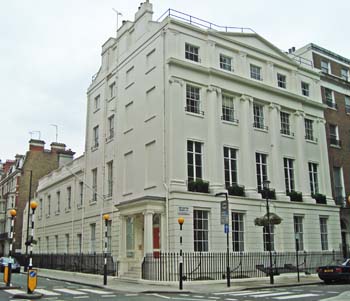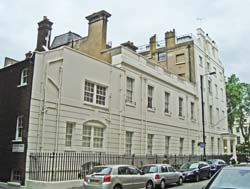Lady Carnarvon's Hospital
for Officers
for Officers
48 Bryanston Square, W1H 2EA
Medical
dates:
Medical
character:
Convalescent
At the outbreak of WW1 the
Countess of Carnarvon (1876-1969) obtained permission to establish a
Hospital for Officers at her home in Highclere Castle. The Hospital
was financed by her godfather and guardian Baron Alfred
de
Rothschild (Lady Carnarvon was widely believed to be his
illegitimate
daughter).
At the end of 1915, finding Highclere offered insufficient scope for her philanthropy, Lady Carnarvon decided to relocate the Hospital to London.
She applied for a lease on a house at No. 48 Bryanston Square, with a view to converting it into a hospital. Although the Trustees of the Portman Estate were reluctant to entertain the application for such a purpose, they were even more concerned that the premises would be
commandeered by the War Office.
The lease secured, the Countess set about the conversion of the building into a hospital. A lift was installed, as well as a purpose-built operating theatre and an X-ray apparatus. The Hospital at Highclere was closed and its staff and equipment transferred to London.
Lady Carnarvon's Hospital for Officers opened in January 1916. It had 40 beds and was affiliated to Queen Alexandra's Military Hospital. As with the hospital at Highclere, Baron de Rothschild paid for the equipment and essential medical supplies, as well as the salaries for both the nursing and domestic staff.
A Matron was in charge of the nursing staff, most of whom were Irish, having been recruited via contacts in horse-racing circles. particularly in Dublin. The domestic staff consisted of a cook, a dozen maids and several footmen.
The Hospital had just opened when Lord Kitchener came to inspect the premises. He was very impressed. The Hospital was quite lavish and some of the 40 beds were in single rooms, but more usually in small wards of 2 to 4 beds each. The wards had been given the same names as the bedrooms at Highclere - Arundel, Stanhope, Sussex, etc. The beds were comfortable and made up with fine linen. Spare pyjamas and clothes were provided for the patients until their families could send up their own.
Things were not quite like other hospitals; one patient, on writing a letter of thanks to Lady Carnarvon, recalled being served breakfast in bed by a butler, before a footman inquired in which order he would care to read the papers.
Fresh produce from the kitchen gardens and orchards at Highclere were sent up regularly for the staff and patients. Convalescent patients were allowed to use the residents' garden, enclosed by railings, in Bryanston Square.
In February 1917 the King and Queen visited.
As the use of aircraft greatly increased during the war, so did the casualties. The Hospital became one of a small number in London that treated patients from the Royal Flying Corps, specialising in burns cases. By 1917 Royal Flying Corps Hospitals had also opened at 37 Bryanston Square and at 82 Eaton Square.
At the end of the war in November 1918 the Hospital still contained some 20 patients. When they were well enough to be transferred to suitable convalescent homes, the Hospital closed on 15th February 1919.
Present status (May 2010)
The Grade II listed building was converted in 2009 from offices into a school for 300 pupils.
At the end of 1915, finding Highclere offered insufficient scope for her philanthropy, Lady Carnarvon decided to relocate the Hospital to London.
She applied for a lease on a house at No. 48 Bryanston Square, with a view to converting it into a hospital. Although the Trustees of the Portman Estate were reluctant to entertain the application for such a purpose, they were even more concerned that the premises would be
commandeered by the War Office.
The lease secured, the Countess set about the conversion of the building into a hospital. A lift was installed, as well as a purpose-built operating theatre and an X-ray apparatus. The Hospital at Highclere was closed and its staff and equipment transferred to London.
Lady Carnarvon's Hospital for Officers opened in January 1916. It had 40 beds and was affiliated to Queen Alexandra's Military Hospital. As with the hospital at Highclere, Baron de Rothschild paid for the equipment and essential medical supplies, as well as the salaries for both the nursing and domestic staff.
A Matron was in charge of the nursing staff, most of whom were Irish, having been recruited via contacts in horse-racing circles. particularly in Dublin. The domestic staff consisted of a cook, a dozen maids and several footmen.
The Hospital had just opened when Lord Kitchener came to inspect the premises. He was very impressed. The Hospital was quite lavish and some of the 40 beds were in single rooms, but more usually in small wards of 2 to 4 beds each. The wards had been given the same names as the bedrooms at Highclere - Arundel, Stanhope, Sussex, etc. The beds were comfortable and made up with fine linen. Spare pyjamas and clothes were provided for the patients until their families could send up their own.
Things were not quite like other hospitals; one patient, on writing a letter of thanks to Lady Carnarvon, recalled being served breakfast in bed by a butler, before a footman inquired in which order he would care to read the papers.
Fresh produce from the kitchen gardens and orchards at Highclere were sent up regularly for the staff and patients. Convalescent patients were allowed to use the residents' garden, enclosed by railings, in Bryanston Square.
In February 1917 the King and Queen visited.
As the use of aircraft greatly increased during the war, so did the casualties. The Hospital became one of a small number in London that treated patients from the Royal Flying Corps, specialising in burns cases. By 1917 Royal Flying Corps Hospitals had also opened at 37 Bryanston Square and at 82 Eaton Square.
At the end of the war in November 1918 the Hospital still contained some 20 patients. When they were well enough to be transferred to suitable convalescent homes, the Hospital closed on 15th February 1919.
Present status (May 2010)
The Grade II listed building was converted in 2009 from offices into a school for 300 pupils.

Wetherby Preparatory School.

The entrance to the building in George Street.

The elevation along George Street.
(Author unstated) 1917 List of the various hospitals treating military cases in the United Kingdom. London, H.M.S.O.
Carnarvon F 2011 Lady Almina and the Real Downton Abbey. London, Hodder & Stoughton.
Cross W 2011 Lady Carnarvon's Nursing Homes: Nursing the Privileged in Wartime and Peace. Self-published.
http://1914-1918.invisionzone.com
http://transact.westminster.gov.uk
www.feildenandmawson.com
www.geograph.org.uk
www.geraldeve.com
www.scarletfinders.co.uk
Return to home page